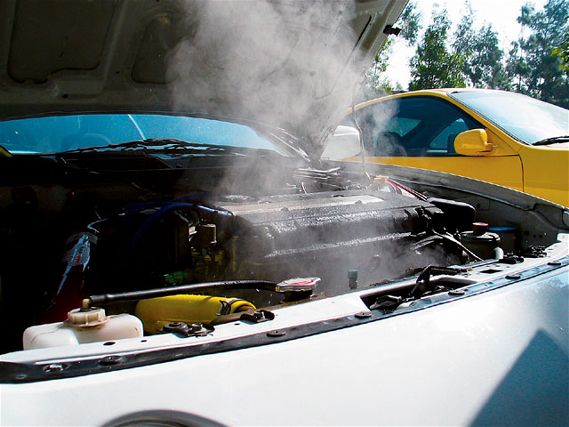 | Overheating Car - Keep Your Cool
| Overheating Car - Keep Your Cool The telltale sign of steam emanating from underneath the hood is something no car owner should ever witness. As the needle of the temperature gauge races towards the danger end you panic that you are going to blow a head gasket any second - and that is if you get off easy. If things get real bad you might warp your cylinder head or block. The steam is your engine's way of telling you it is really pissed off, and you don't want to anger your engine because severe overheating can destroy your engine. In cases of overheating, pull over and let the engine cool off before opening the radiator cap. If you are in a hurry and open the radiator cap as soon as you get to the side of the road you just might be in store for a visit to the ER. Boiling hot coolant and steam could scald your hands, arms, and face.
It is no surprise that you see more cars pulled over to the side of the road during the summer months than during the winter. The hotter ambient temperatures contribute to this, but also, more times than not, just because the outside temperature is hot doesn't mean we like to be, so the air conditioning is turned on to keep us cool. Once you click the A/C button the magnetic clutch on the air conditioning pump is engaged, placing an extra load on the engine. This extra load makes the engine work harder and generates more heat within the engine.
Most of us will probably experience an overheating car at least once in our lifetime. Unfortunately, however, most of us do not know what to do when a vehicle starts to overheat. Be smart and pull over immediately and turn off the vehicle. The next best thing you can do is to call a tow truck and have it towed to your local mechanic and have the vehicle inspected.
The worst thing you can do is to open the radiator cap and poor water into the radiator. If you are lucky and don't get burned by the hot coolant and steam when you open the cap, the water you poured into the radiator is likely to spew back out, possibly causing burns.
Why is that you ask? Well, first off, what's left of the coolant still in the radiator is probably around 220-plus degrees Fahrenheit. The reason being is that most coolants are glycol-based liquids, which have a significantly higher boiling point. When you pour water, which has a boiling point of 212-degrees F, into the radiator the water is instantly superheated to its boiling point causing it to instantly boil over. Besides the potential of getting burned, the colder water temperature introduced into the radiator can also wreck havoc on internal engine parts. The temperature shock can cause cracks in the cylinder head or the block and can quite possibly put an end to your engine.
Like many of our DIY Tech articles, changing your engine coolant is a must and can easily be done with simple hand tools. With the summer months lingering around the corner you want to enjoy cruising the boulevard, not stuck on the side of the road tending to a second-degree burn. Follow along as we show you the steps as we change out the coolant in an Acura Integra.
